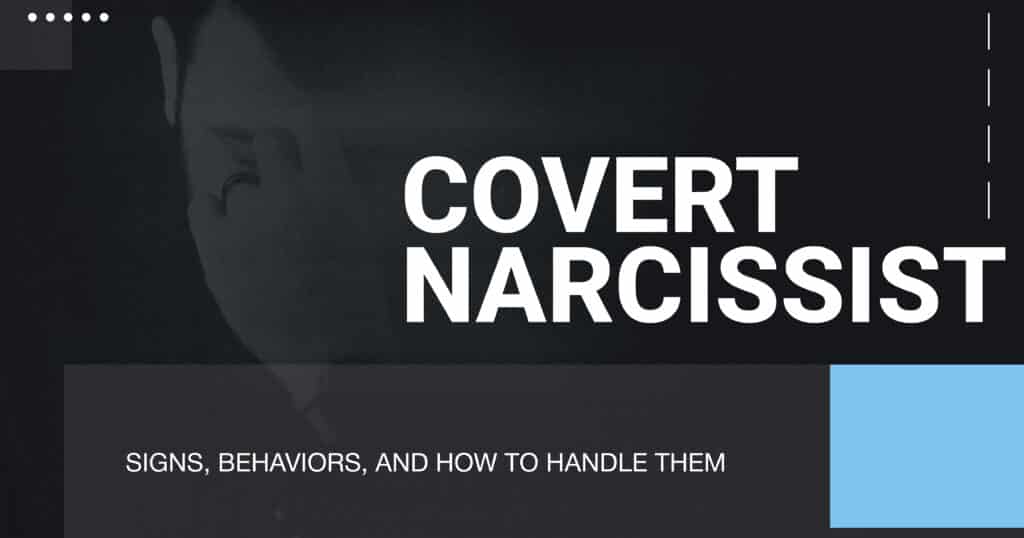Interacting with a covert narcissist can feel like walking through an emotional minefield – subtle, confusing, and draining. Unlike their more flamboyant counterparts, covert narcissists hide their narcissistic traits behind a facade of humility or victimhood, making them harder to spot. Their manipulative behaviors, like gaslighting or passive-aggressive behavior, can leave you questioning your reality and self-worth.
This article unpacks the covert narcissist, exploring their narcissistic personality disorder (NPD) traits, manipulation tactics, and strategies for dealing with a covert narcissist. It also covers healing from narcissistic abuse to help you reclaim your emotional strength and move forward with confidence.
What Is a Covert Narcissist?
A covert narcissist is someone with narcissistic personality disorder (NPD) who displays their narcissistic traits in subtle, less obvious ways compared to overt narcissists. While they share the same core characteristics – such as a superiority complex, fragile ego, and low empathy – covert narcissists often present as shy, self-effacing, or overly sensitive. This makes their toxic personality harder to detect, as they may seem like victims or misunderstood souls rather than self-absorbed manipulators.
Covert narcissism is rooted in a deep need for validation and admiration, but instead of seeking it through grandiosity, they use emotional manipulation or play the martyr. According to the American Psychological Association, NPD affects about 1–2% of the population, with covert presentations being less studied but equally damaging. Recognizing a covert narcissist is the first step toward protecting yourself and seeking narcissistic abuse recovery.
Key Traits That Distinguish Covert Narcissism
The narcissistic traits of a covert narcissist blend arrogance with insecurity, creating a unique profile. Here’s what sets them apart:
- Fragile Ego. They’re hypersensitive to criticism, reacting with defensiveness or silent resentment.
- Low Empathy. They struggle to genuinely care about others’ feelings, despite appearing compassionate.
- Superiority Complex. They quietly believe they’re better than others, often feeling misunderstood or underappreciated.
- Victim Mentality. They portray themselves as sufferers to gain sympathy and control.
These traits make covert narcissists masters of emotional manipulation, as they leverage their perceived vulnerability to influence others. A childhood trauma test or therapy can sometimes reveal underlying insecurities driving these behaviors, though change is rare without professional intervention.
| Trait | Description | How It Manifests | Impact on Relationships |
| Fragile Ego | Extreme sensitivity to criticism | Sulking, defensiveness | Tension, walking on eggshells |
| Low Empathy | Limited genuine care for others | Dismissing others’ needs | Emotional neglect, one-sided bonds |
| Superiority Complex | Hidden belief in being better | Subtle bragging, resentment | Undermines mutual respect |
| Victim Mentality | Portraying self as wronged | Guilt-tripping, seeking sympathy | Manipulative dynamics |
Covert Vs Overt Narcissistic Personality Disorder (NPD)
While both covert and overt narcissists share narcissistic personality disorder (NPD), their presentations differ significantly. Understanding these differences helps in dealing with a covert narcissist effectively.
| Aspect | Covert Narcissist | Overt Narcissist |
| Presentation | Shy, humble, or victim-like | Arrogant, boastful, attention-seeking |
| Manipulation | Subtle, passive-aggressive behavior | Direct, domineering, or charming |
| Emotional Impact | Confusion, self-doubt via gaslighting | Intimidation, feeling belittled |
| Social Perception | Seen as sensitive or misunderstood | Viewed as confident or self-absorbed |
Both types rely on emotional manipulation, but the covert narcissist’s subtlety makes them harder to confront. Recognizing these distinctions is key to setting boundaries and seeking narcissistic abuse recovery.
Common Behaviors and Manipulation Tactics
Covert narcissists deploy a range of behaviors to maintain control and feed their fragile ego. These narcissistic traits are often cloaked in seemingly innocent actions, making their toxic personality difficult to pinpoint. Common tactics include:
- Gaslighting. Making you question your reality, like denying events or twisting your words.
- Passive-Aggressive Behavior. Indirect hostility, such as silent treatment or backhanded compliments.
- Emotional Control. Using guilt or sympathy to manipulate your actions or feelings.
- Triangulation. Pitting people against each other to maintain power or attention.
These behaviors erode self-esteem and create dependency, hallmark effects of narcissistic abuse. Identifying them is crucial for dealing with a covert narcissist and beginning emotional healing.
Gaslighting, Passive-Aggression, and Emotional Control
Gaslighting is a signature tactic, where the covert narcissist distorts reality to make you doubt your perceptions. For example, they might insist, “I never said that,” when you know they did, leaving you confused. Passive-aggressive behavior shows up as subtle jabs or withholding affection to punish without confrontation. Emotional control often involves guilt-tripping, like saying, “After all I’ve done for you,” to enforce compliance.
These tactics are insidious because they’re hard to call out. Victims may feel trapped, blaming themselves for the covert narcissist’s behavior. Therapy or a childhood trauma test can help uncover how these dynamics mirror past patterns, aiding narcissistic abuse recovery.
How to Deal With a Covert Narcissist?
Dealing with a covert narcissist requires strategy and emotional resilience to protect your well-being. Their emotional manipulation can make direct confrontation tricky, so focus on self-preservation and clear boundaries. Here are practical steps:
- Set Firm Boundaries. Clearly define acceptable behavior and stick to them, like limiting contact if they disrespect you.
- Don’t Engage Emotionally. Avoid reacting to gaslighting or guilt trips; respond calmly with facts.
- Practice the Gray Rock Method. Be neutral and uninteresting to reduce their ability to manipulate you.
- Seek Support. Connect with trusted friends or a therapist to validate your experiences.
The no contact rule – cutting off all communication – is often the most effective way to break free, especially in toxic relationships. If no contact isn’t possible, like with a coworker, setting boundaries and minimizing interaction are key. Clear Mind Treatment can offer guidance on dealing with a covert narcissist, helping you navigate these complex dynamics.
Healing From Narcissistic Abuse
Healing from narcissistic abuse is a journey of rebuilding self-esteem, trust, and emotional strength. The effects of a covert narcissist’s emotional manipulation can linger, causing self-doubt, anxiety, or difficulty trusting others. Recovery involves addressing these wounds through professional support, self-care, and intentional steps toward emotional healing.
Key components of recovery include:
- Therapy. Therapy for narcissistic abuse survivors helps process trauma and rebuild self-worth.
- Self-Care. Prioritizing rest, hobbies, and healthy relationships nurtures emotional health.
- Support Networks. Connecting with others who’ve faced narcissistic abuse validates your experience.
- Education. Learning about narcissistic personality disorder (NPD) empowers you to recognize red flags.
Recovery isn’t linear, but each step forward helps you reclaim your sense of self. Self-care after narcissistic abuse is critical to breaking the cycle of pain and fostering resilience.
Therapy, Self-Care, and the No Contact Rule
Therapy for narcissistic abuse survivors is a cornerstone of narcissistic abuse recovery. Approaches like Cognitive Behavioral Therapy (CBT) help reframe negative beliefs caused by gaslighting, while Eye Movement Desensitization and Reprocessing (EMDR) processes traumatic memories. Trauma-focused therapy can address underlying wounds, sometimes uncovered through a childhood trauma test, that made you vulnerable to a covert narcissist.
Self-care after narcissistic abuse involves small, consistent acts – like journaling, exercise, or mindfulness – to rebuild emotional stability. The no contact rule is often essential, severing ties to prevent further manipulation. If no contact isn’t feasible, low contact with strict setting boundaries can work. These strategies, combined with professional support, pave the way for emotional healing.
| Recovery Strategy | Description | Benefits | How to Implement |
| Therapy | Professional support for trauma | Processes pain, builds coping skills | CBT, EMDR with a licensed therapist |
| Self-Care | Prioritizing personal well-being | Boosts self-esteem, reduces stress | Journaling, exercise, healthy hobbies |
| No Contact Rule | Cutting off communication | Prevents further manipulation | Block communication, avoid triggers |
| Support Networks | Connecting with understanding peers | Validates experiences, reduces isolation | Join support groups, confide in friends |
Recovering From Narcissistic Relationships? Contact Clear Mind Treatment for Support
Clear Mind Treatment is here to support your narcissistic abuse recovery with compassionate, tailored therapy. Our team offers therapy for narcissistic abuse survivors, including CBT and EMDR, to help you process emotional manipulation and rebuild confidence. Whether you’re learning to deal with a covert narcissist or seeking self-care after narcissistic abuse, we provide a safe space to heal.
Take the first step toward emotional healing. Contact Clear Mind Treatment today to schedule an assessment, discuss therapy options, or learn how to start healing from narcissistic abuse. Call us at [insert contact number] or visit our website to connect with a team dedicated to your recovery.
FAQs
What are the signs of a covert narcissist?
A covert narcissist shows narcissistic traits like a fragile ego, low empathy, and a superiority complex, often masked by humility or victimhood. Look for passive-aggressive behavior and subtle emotional manipulation.
How does a covert narcissist manipulate others?
They use gaslighting, passive-aggressive behavior, and guilt-tripping to control others emotionally. These tactics create self-doubt and dependency, hallmark signs of a toxic personality.
What is the difference between a covert and overt narcissist?
A covert narcissist is subtle, using emotional manipulation and victimhood, while an overt narcissist is openly arrogant and attention-seeking. Both share narcissistic personality disorder (NPD) but differ in presentation.
How do you deal with a covert narcissist?
Dealing with a covert narcissist involves setting boundaries, using the gray rock method, and the no contact rule when possible. Support from therapy or trusted allies helps maintain emotional strength.
Can therapy help victims of narcissistic abuse?
Yes, therapy for narcissistic abuse survivors like CBT or EMDR aids narcissistic abuse recovery by processing trauma and rebuilding self-esteem. It’s a vital tool for emotional healing.






